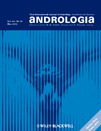Hyperviscosity of semen in patients with male accessory gland infection:direct measurement with quantitative viscosimeter
Summary
The aim of this study was to evaluate whether the viscosity of semen in patients with male accessory gland infection is related to the extension of the inflammatory process to the various glands. To achieve this, viscosity was assessed by quantitative viscosimeter and the results were expressed in centipoise (cps). The study was conducted on 30 infertile patients with clinical evidence of male accessory gland infection and a mean age of 29.0 ± 4.0 years. Their semen viscosity was evaluated through quantitative viscometer. All patients showed an increase of viscosity evaluated according to WHO criteria, while this parameter was normal in all controls. Semen viscosity of patients with male accessory gland infection (28.6 ± 2.2 cps) was significantly (P < 0.05) higher than that in the controls (10.7 ± 0.6 cps). Significantly increasing values were observed in patients with involvement of multiple gland inflammation (prostatitis <prostato-vesiculitis < prostato-vesiculo-epididymitis). The viscometry allows us to identify a quantitative score more severely in more extended forms. It therefore represents a valuable diagnostic tool in clinical practice, which also allows better monitoring of treatment response of male accessory gland infection.




